The Purpose of the Needs Assessment
- Homelessness rates in the USA are increasing:
- *2.8 million people without shelter annually (Gwadz et al., 2017).
- Homeless young people are exposed to numerous threats.
- The population of concerns is homeless youth.
- The needs assessment helps identify the correlation between the accessible services and the actual needs of the homeless.
- The presentation addresses data collection, key findings, recommendations, and reflection.
The community of California, as well as the USA in general, experiences an increase in the number of homeless young people under age 18. Overall, the number of young individuals without shelter equals to 2.8 million people every year (Gwadz et al., 2017). The homeless are at risk of being exposed to violence, physical and mental health problems, sex trafficking, early pregnancy, substance abuse, and other severe threats which might lead to deaths. The literature review and the analysis of the existing programs show that the majority of drop-in centers primarily provide accommodation and food. They pay secondary attention to psychological support and substance abuse treatment (Morton et al., 2018; Middleton et al., 2018). In spite of the number of available supporting organizations, there exists a problem with their accessibility for homeless underage individuals.
The population of concerns is homeless youth under age 18 who seek shelter in the community of San Diego, California. The purpose of needs assessment is to contribute to the overall understanding of the correlation between the real needs of homeless youth and the quality of services they can obtain. It is vital to implement the needs assessment procedure to improve the performance of the agencies and contribute to the well-being of the American youth. This presentation will include the description of data collection procedures, key findings and recommendations, outcome dissemination, and reflection on the results.
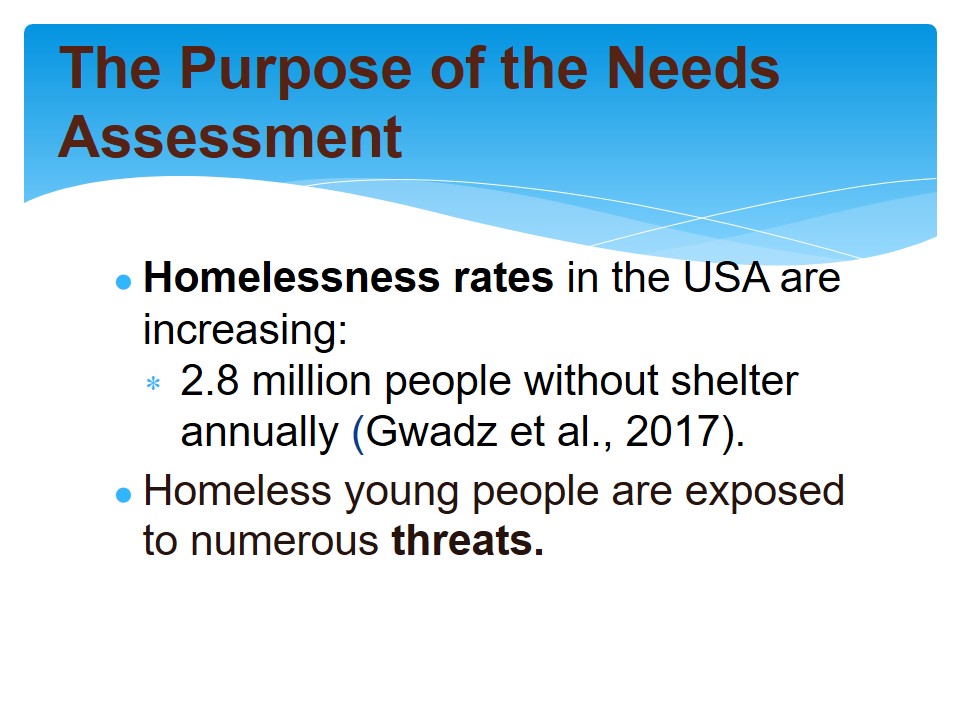
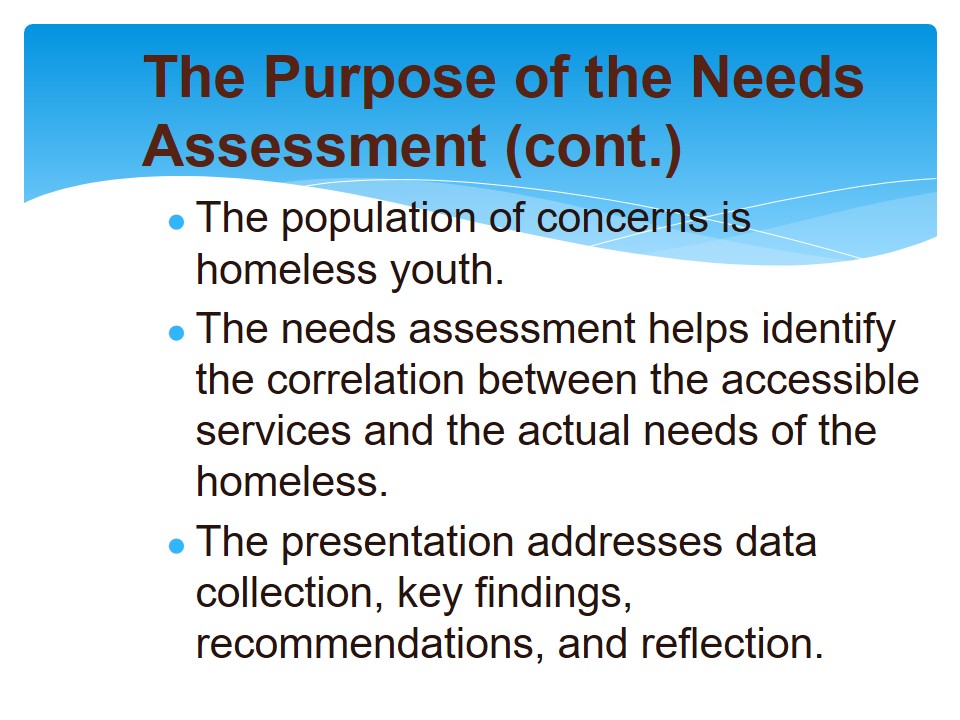
Data Collection Process
- Interview was chosen as the data collection method.
- There were five interviews with the representatives of five drop-in centers.
Interview sites and participants description:
- California Homeless Youth Project.
- YMCA Youth and Family Services.
- The San Diego Youth Services Counseling Cove.
- Storefront Drop-in.
- The Toussaint Academy of Arts and Science.
The data collection was conducted utilizing the interviewing method. The interviews with the representatives of the agencies providing services for homeless youth in San Diego were held over the phone. The questions addressed to the representatives concerned the risks, the most severe and widely spread problems, and needs of homeless young people under age 18. There were five interviews conducted with the representatives of five drop-in centers in San Diego.
Interview sites and participants were California Homeless Youth Project. This service in San Diego has one drop-in center, two emergency shelters with 40 beds, one long-term shelter with 30 beds, one transitional living program with ten beds, one counseling program, and one educational program (“About the California homeless youth project,” n.d.). YMCA Youth and Family Services supports over 15,000 individuals in the San Diego County community each year (“Youth and family services,” 2019, para. 1). The San Diego Youth Services Counseling Cove specializes in professional mental health support without sleeping arrangements. Storefront Drop-in is a center for children with 20 beds. The Toussaint Academy of Arts and Science long-term shelter provides 30 beds for homeless youth and has a developed educational system.
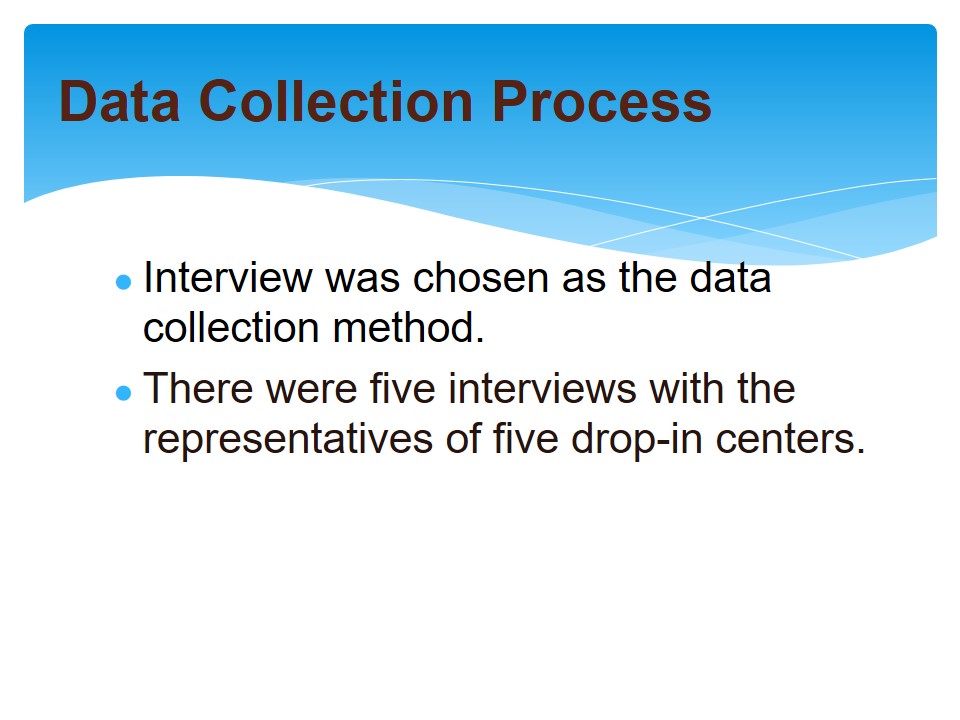
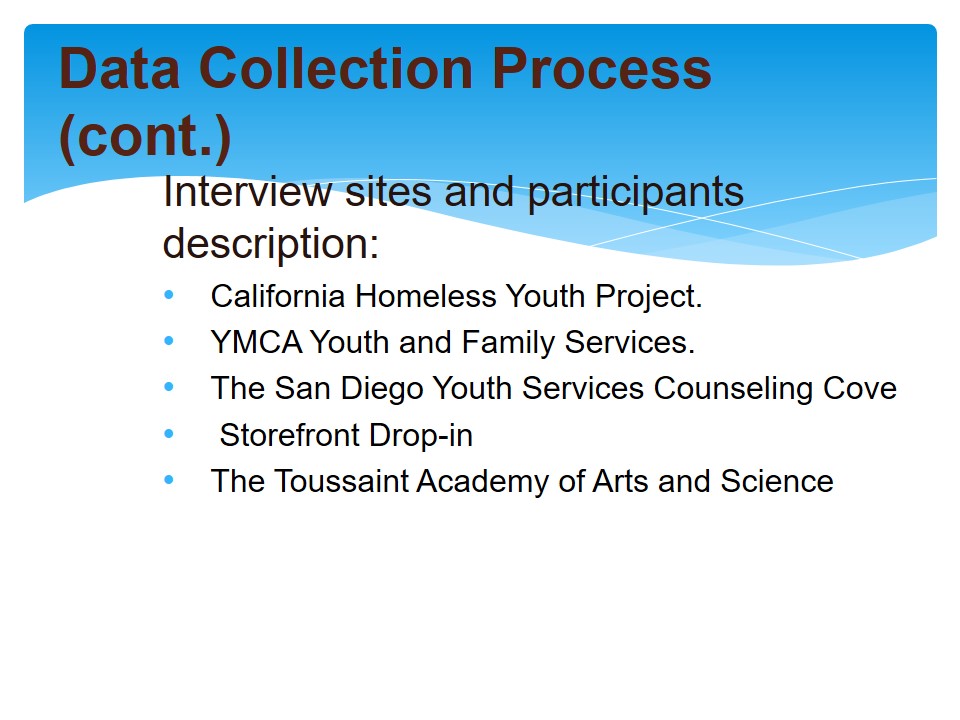
Key Findings
- Research questions:
- threats;
- primary needs;
- accessibility;
- challenges.
- Results:
- the biggest risks are substance abuse, street violence, early pregnancy, and mental health problems;
- the homeless need shelter, food, psychological and educational support;
- the centers lack facilities and advertisement;
- the lack of funding.
The main research questions include the following:
- What are the threats and risks homeless youth in San Diego face?
- What are their primary needs?
- How accessible are the services of the centers?
- What challenges do the centers face in the service delivery process?
The main results of the conducted interviews contributed to answering each research question.
- The majority of the interviewees stated that homeless youth experience street violence, drug and alcohol abuse. They are at risk of early pregnancy, drug addiction, physical and mental health issues.
- The primary needs of this population are shelter and food, health care services, psychological support, and educational assistance.
- The accessibility is one of the key factors in drop-in facilities work (Haskett, 2017). Three out of five centers’ representatives stated that the lack of shelter places impose difficulty for the youth to access the facilities. All centers lack advertising of their services.
- The main challenge for the centers’ service delivery is the lack of funding which is a core of the difficulties related to staffing, accommodation, and the overall quality of work.
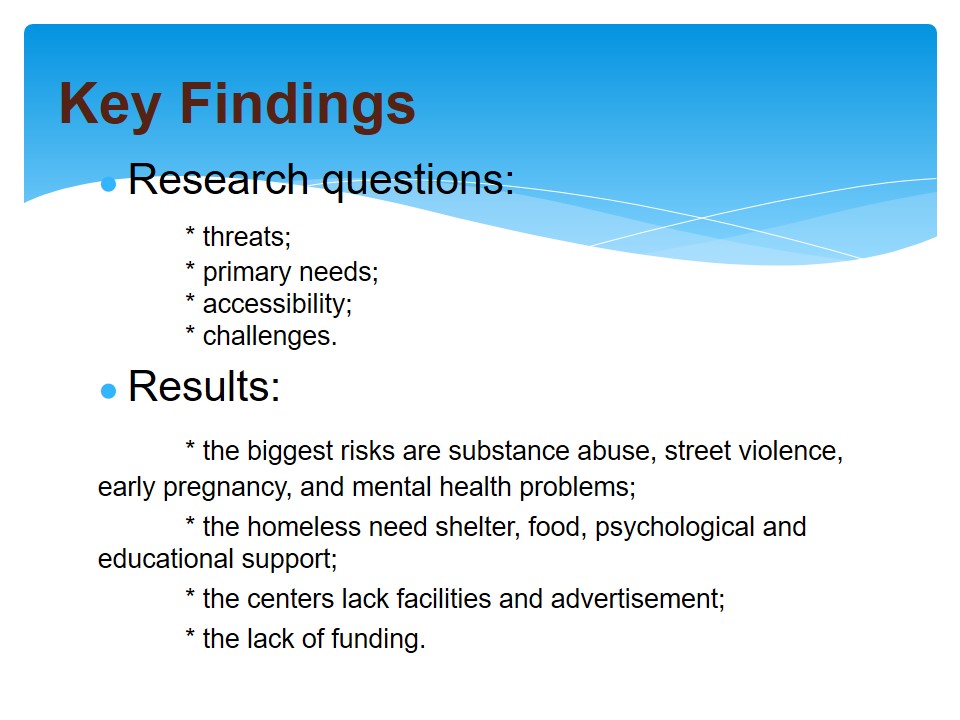
Recommendations
- To provide educational and counseling services.
- To enlarge the number of beds in the facilities.
- To improve the presence of advertisements.
- To attract volunteers and funds.
The results of the needs assessment provide an opportunity to construct a recommended action plan for the centers to help them meet the requirements of the target population. It is essential to develop special programs to provide educational and counseling services apart from accommodation and food. The centers’ management should enlarge the number of beds in the facilities to be able to host more homeless youth. In order to increase the accessibility of the facilities, it is vital to improve the presence of advertisements in the media for those who need help could have the necessary information. To succeed in all recommended activities, the centers should attract volunteers and sponsors to improve funding.

Outcome Dissemination
- The recommendations should be specifically designed for each interviewed center.
- The information will be shared via e-mail letters.
Recommendations representation for each center requires the analysis of the opportunities of each interview site. The recommendations appropriate for the particular center will be shared. The recommendations will be sent to the representatives of the centers via emails. The information will include key findings and action plans developed on the basis of the results. The contact information that was retrieved during the interviews will be utilized to personally address each representative.
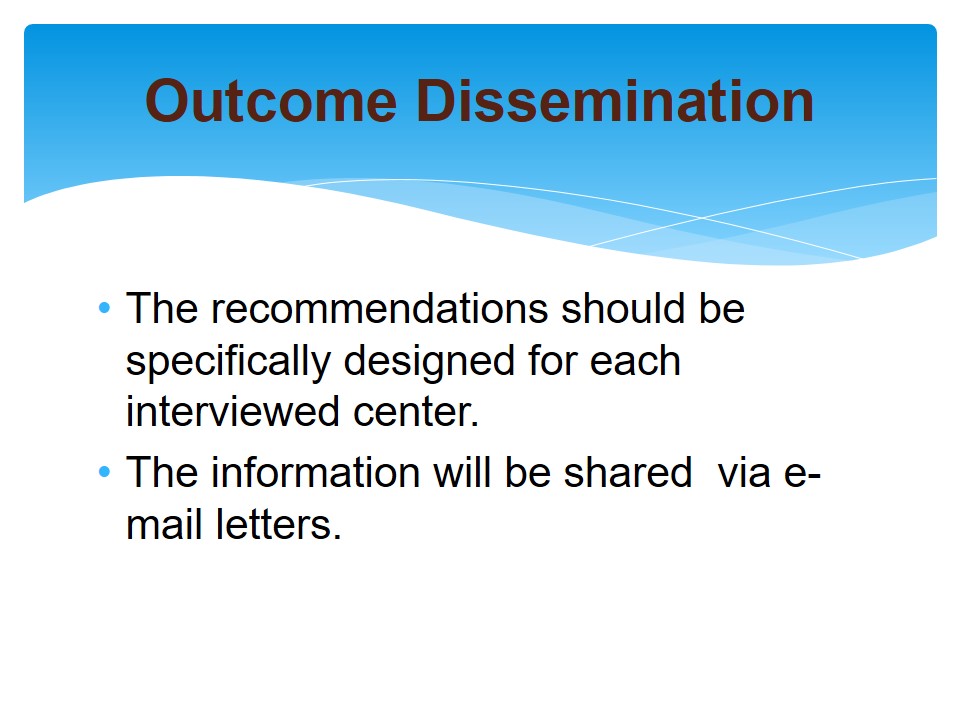
Reflection
- Literature analysis and facilities research contributed to the effectiveness of the assessment.
- Prepared interview questions facilitated the retrieval of the information.
- Time limitation due to the inaccessibility of the participants imposed difficulty.
- Precise planning and the establishment of contact during the interview are key for success.
- The experience was challenging.
- The assessment enriched the understanding of data collection methodology.
- The community is exposed to the increase in the number of homeless youth.
- The organizational process is multi-faceted.
Thorough literature analysis and facilities research contributed to the effectiveness of the needs assessment. Concise and thought-through interview questions facilitated the interviewing process and contributed to the retrieval of the necessary information. Time limitation due to the inaccessibility of the participants caused some barriers to the success of the assessment. The carried out needs assessment procedure provided a valuable lesson for future interventions. It is vital to conduct precise planning when working on the materials. Also, it is important to establish contact during the interview with a participant to ensure the validity and accuracy of the information.
The experience of needs assessment and working with the organizations was challenging. This activity enriched my understanding of data collection methodology. I learned that the community is exposed to the increase in the number of homeless youth and it is important to address this issue on the managerial level. However, the organizational process is multi-faceted, and any change can be made only upon the completion of several steps.
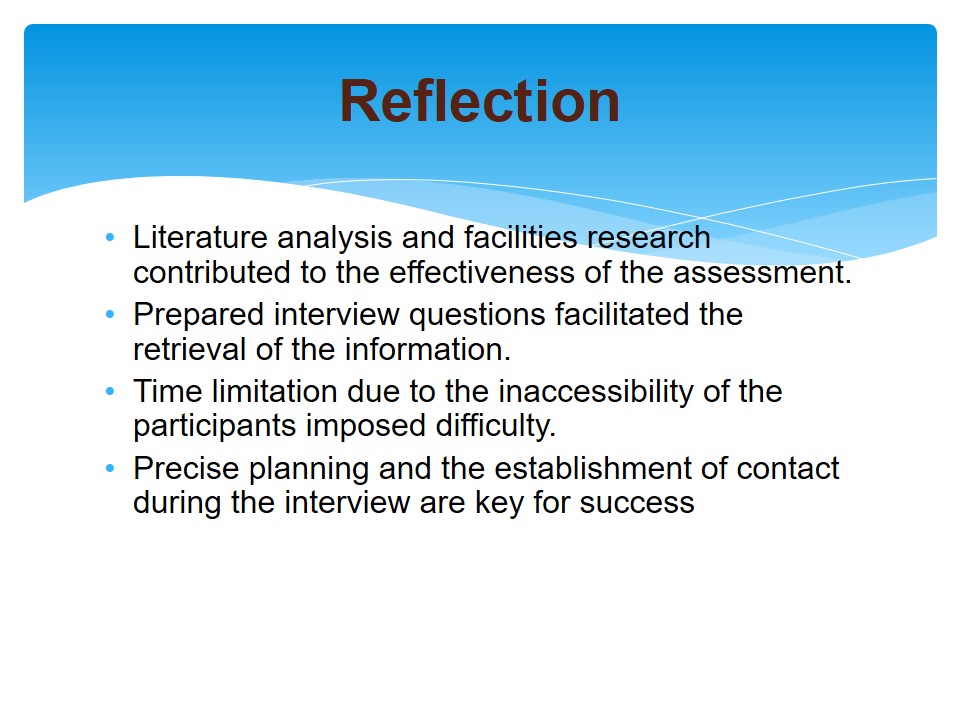
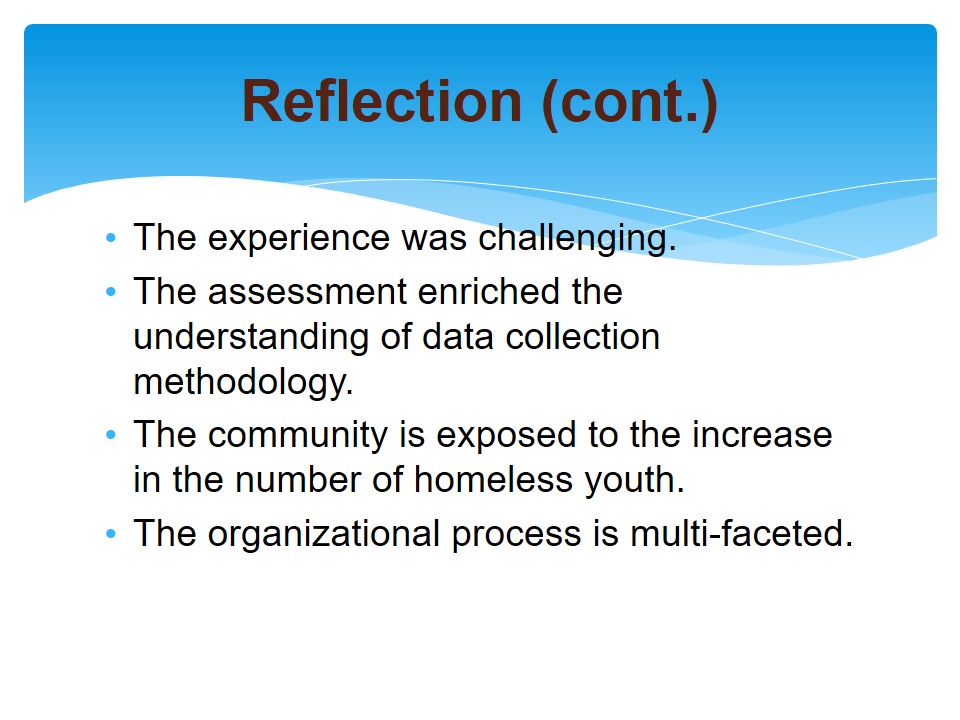
References
About the California homeless youth project. (n.d.). Web.
Gwadz, M. V., Cleland, C. M., Leonard, N. R., Bolas, J., Ritchie, A. S., Tabac, L., … Powlovich, J. (2017). Understanding organizations for runaway and homeless youth: A multi-setting quantitative study of their characteristics and effects. Children and Youth Services Review, 73, 398-410.
Haskett, M. E. (2017). Child and family well-being and homelessness: Integrating research into practice and policy. Cham, Switzerland: Springer.
Middleton, J. S., Gattis, M. N., Frey, L. M., & Roe-Sepowitz, D. (2018). Youth experiences survey (YES): Exploring the scope and complexity of sex trafficking in a sample of youth experiencing homelessness. Journal of Social Service Research, 44(2), 141-157.
Morton, M. H., Dworsky, A., Matjasko, J. L., Curry, S. R., Schlueter, D., Chavez, R., & Farrell, A. F. (2018). Prevalence and correlates of youth homelessness in the United States. Journal of Adolescent Health, 62(1), 14-21.
Youth and family services. (2019). Web.